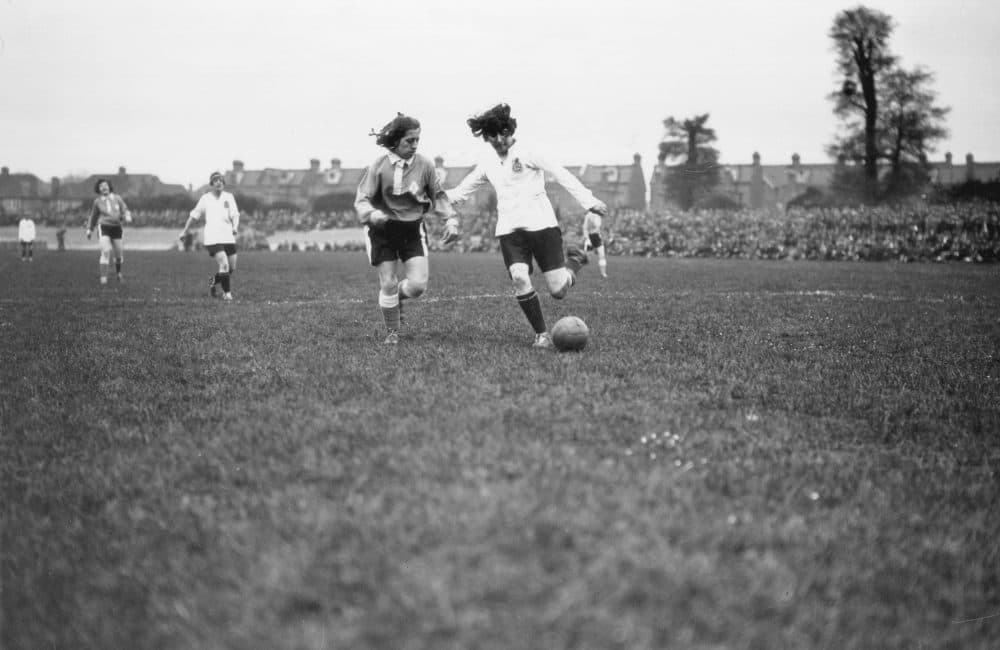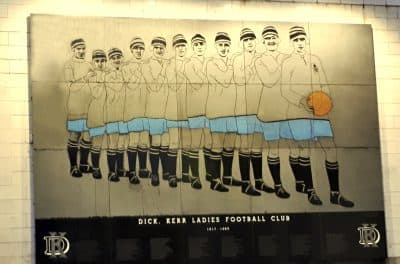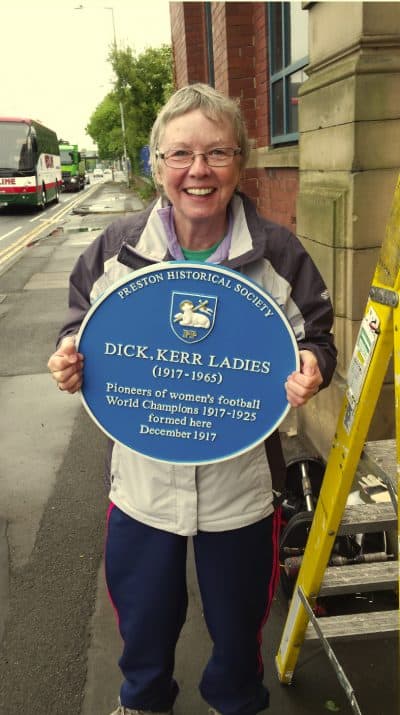Advertisement
From A WWI Munitions Factory To England's Top Stadiums: The Dick, Kerr Ladies FC

In 1917, at the Dick, Kerr Company in Preston, Lancashire, England, business was booming. World War I was eating up all the munitions the plant could produce.
But even in those dire days, there was time for recreation. The Dick, Kerr Company, like lots of shops and factories and towns in England, sponsored a soccer club. One day during a lunch break, the men who were still at work rather than in uniform were practicing, and the women who’d been employed when the supply of male workers began to dwindle, were looking on.
"What we know about it is that the women who were watching were not that impressed," says professor Laurent Dubois, who teaches a course called "Soccer Politics" at Duke University. "And so that’s the beginning of the story, really."
One of those unimpressed women was Grace Sibbert.
"She just laid down a challenge, in a sense, which was to say: 'We probably could do better than you at this game.' Soon enough, they played a game. And I think partly what happened was that other women realized that they would really enjoy playing this game."

So the Dick, Kerr women’s soccer team began with a challenge and the discovery that soccer was fun. And shortly thereafter, with the arrival of a worker named Lilly Parr, it got serious.
"She was very young when she started working at the factory. I think 14. A kind of tough worker," Dubois says. "And she just seems to have been this incredibly intense forward. Clearly a very threatening and intense presence at the front of that team."
“How threatening?” you may ask. “How intense?” Preston, Lancashire’s own Gail Newsham can answer that. She grew up close to the site of the Dick, Kerr plant, and her writing about the women’s team includes a particular Lilly Parr story.
"They were kicking it and warming up before the game, and there was this professional male goalkeeper watching them. He went down to their end of the field, and he just said, 'You’d never score a goal past me.' Well, you didn’t really talk to Lilly like that and get away with it. So she said, 'All right, then. You get in the goal and I’ll take a penalty against you.'
Advertisement
"So she put the ball on the spot and ran up and took a shot at him, and he put his arms up to try to save it, and the power of the shot broke his arm. So he was then crying, 'Somebody take me to the hospital. She’s broken me arm!' You don’t mess with Lilly Parr."
A Popular Attraction
The Dick, Kerr women’s team took on all comers, female or male, and became a popular attraction.
"It really kind of expands and booms. And part of the fact is that a lot of the audiences are men. Men are going to these games," Dubois says. "There’s accounts in Gail Newsham’s book of really, really large games."
How large?
"The biggest crowd that they played in front of was at Goodison Park, Everton, when 53,000 people came to watch them play," Newsham says. "And there were between 10,000 and 14,000 locked out, unable to gain admission."
That was, perhaps, too many people for the Football Association, which was and is in charge of the game in England.

"Just my own opinion, but I think the 53,000 at Goodison on Boxing Day, 1920 — I think that was an alarm bell for the establishment," Newsham says. "It was really quite big, and I think probably that’s why the FA then chose to ban them from playing, because they were getting too successful."
At a time when the Football Association was expanding and energetically promoting the men’s game, what could be more sensible than banning women from the pitch? Laurent Dubois shares Gail Newsham’s take on that policy decision.
"They clearly became very concerned about this rise of women’s soccer," he says. "And I think partly that there was literally a fear of competition with the men’s game. And I’m sure, obviously, just a more ingrained sexism in the way they were thinking about it.
"They obviously could not ban women from playing soccer on their own when they wanted to, but they took away, kind of, all the infrastructure that had been sustaining these leagues and these places, saying they can’t use the official pitches. If you were a referee, you weren’t supposed to referee a women’s game, and so forth."
Crossing Oceans And Borders
Rather than take their ball and go home, the Dick, Kerr women’s team got on a boat and sailed across the ocean.
"When they arrived in Canada, they were told that the Dominion Football Association had refused permission for them to play there," Newsham explains.
Oh, Canada. Would that you’d been more glorious and free. The Dominion Football Association’s decision meant the Dick, Kerr team would have to cross another border and find men’s teams to play against in the U.S.
"They weren’t too happy about it, but they had to agree," Newsham says. "And they played nine games. They won three, drew three, and lost three."

Despite — or perhaps because of — the success of the Dick, Kerr team, the Football Association’s ban prevailed until the late ‘60s. And it caught on. The German football association banned women’s soccer from 1955 until 1970. In Brazil, which has recently produced several of the game’s most accomplished female players, women’s teams were banned from 1941 until 1979.
Obviously the Football Association’s initial ban was bad for the women who wanted to play soccer and the people who wanted to watch them. But it was also bad for anybody who cared about maintaining a complete record of the culture of women’s sports — and women in general.
"The FA sort of succeeded in kind of erasing that legacy and silencing it," Dubois says. "And even FIFA today sort of presents itself like they’re almost supporting a new thing, right? When we understand that they were there in the early 20th century, that they were playing, that they had the success, I think that gives us a very different way of thinking about women’s soccer today."
'It Is Growing, And It’s Wonderful To See'
If the triumphs and popularity of the Dick, Kerr women’s team had not been buried…ah, well, maybe it’s pointless to speculate about how much further along women’s soccer might be. Better, perhaps, to celebrate with Gail Newsham how far the women’s game has come since all those bans against it were finally lifted.
"It is growing, and it’s wonderful to see," she says. "We have professional women footballers now, and that’s something I couldn’t even dream of when I was young. I would give me right arm for the opportunities that they have today, that’s for sure.
Gail Newsham’s book is "In A League of Their Own: The Dick, Kerr Ladies 1917-1965." Laurent Dubois has written "The Language of the Game: How To Understand Soccer."
This segment aired on April 28, 2018.
